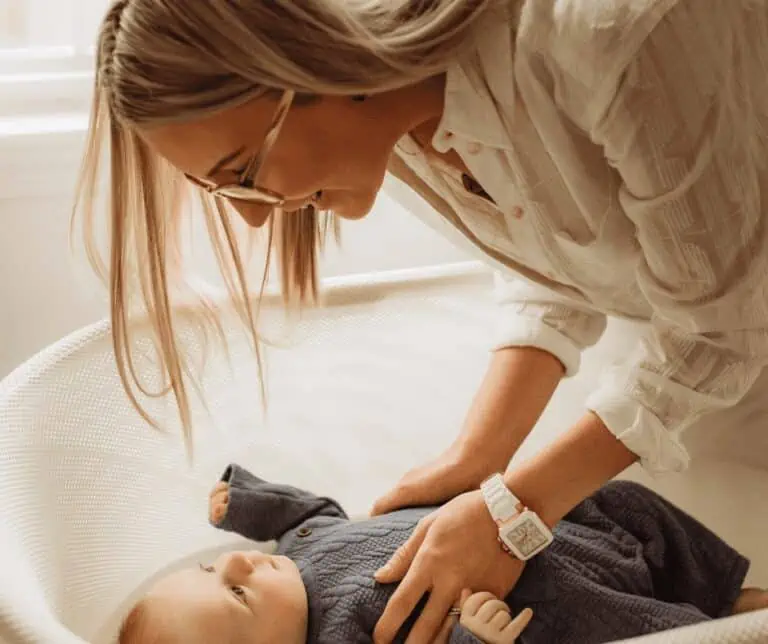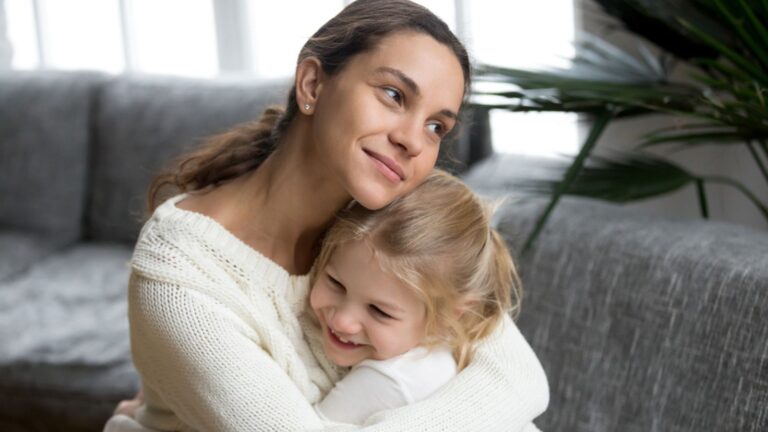How to Get Baby to Sleep in Crib
This post may contain affiliate links. As an Amazon Associate, I earn from qualifying purchases.
Sleep deprivation is a common issue faced by many parents. As your baby grows, transitioning from sleeping in a bassinet (or co-sleeping) to sleeping in their own crib can be an especially challenging step for both parent and child. Going from being close to mom and dad’s warmth at night to sleeping alone in a crib can make it difficult for baby to fall asleep.
But with the right preparation and knowledge, you can make the transition from bassinet to crib smoother for you and your baby. This guide will provide tips on how to help your baby fall asleep soundly and safely in their own crib.
The Benefits of Getting a Baby to Sleep in a Crib
The first step to getting your baby to fall asleep in their crib is understanding why it’s important. Let’s review the top benefits:
- Cribs are designed for safety and provide adequate room for your baby as they grow
- Sleeping in a crib, when set up appropriately, also reduces the risk of Sudden Infant Death Syndrome (SIDS)
- Having your baby sleep in their own bed allows them to develop their sleep routine and teaches self-soothing techniques
- If your baby is sleeping better, you will get better sleep too! A rested mama (when possible) is less reactive and more attuned to their baby.
Are there any disadvantages to having a baby sleep in a crib? Some parents may perceive difficulties getting up in the middle of the night if the baby awakes and has repeated trouble falling asleep. Plus, co-sleeping (although not recommended by medical professionals) can be comforting for both baby and mama. Ultimately, it’s up to you to keep everyone’s safety in mind and choose what’s best for you.
Related Read: Safe Sleep Tips for Newborns
Tips for Getting Your Baby to Sleep in a Crib
Now that you understand the importance of getting your baby to sleep in their crib, it’s time to put these tips into practice:
Establishing an Age-Appropriate Bedtime Routine
Creating a consistent and soothing bedtime routine helps your baby associate certain cues with sleep. This can be anything from giving them a bath, reading a storybook, saying goodnight to family members, playing calming music, or giving them a massage.
Your routine will vary with the baby’s age and preferences. Ultimately, you’ll want them to know what to expect each night when it’s time to lie down in their crib.
Setup Baby’s Room to Encourage Sleep
The environment in your baby’s room can greatly impact their sleep quality and impact how baby falls asleep. A few factors to consider for an optimal sleep environment are:
- Temperature. Ensure the room is neither too hot nor too cold and that their swaddle (if still appropriate) or sleep sack keeps them comfortable all night long.
- Lighting. Keep the lights low and avoid bright lights. You may also want to invest in blackout curtains or shades if sunlight streams into the room early in the morning.
- Noise. Remove distractions that could disrupt their sleep, like loud music, TV, or conversations between family members.
Putting Baby Down Drowsy
Most parents are keen to put their baby in their crib peacefully and without tears. But what if the baby wakes and protests and doesn’t want to sleep in the crib? It’s hard to handle, but you can take proactive steps to avoid having your baby become too upset.
Try putting them down when it’s time for bedtime when they are still drowsy but awake. Whether they prefer to be rocked, nursed, or snuggled to sleep- you can still enjoy these moments and work on transitioning them to the crib awake. It may take several tries. At first, you may need to sing, shush, or place a reassuring hand on their back as they settle in.
Overall, building this habit will help them make the connection between lying in their crib and going to sleep.
Other Tips for Getting Baby to Fall Asleep in a Crib
- Try putting baby down in the crib for naps- this will enhance your efforts to get baby to sleep in the crib
- Make sure your baby is getting enough sleep during the day to ensure they aren’t overtired when it’s time for bed (especially their first nap). On the other hand, make sure your baby has enough awake time before bed, too (this will vary with the baby’s age).
- Stay tuned into your baby’s cues for the transition to make the process as smooth as possible.
- If the baby is sick, recently vaccinated, or is teething, you might want to delay your efforts until they feel better.
- Practice, practice- you get to decide for how long and when your baby needs more help getting to sleep
- Be patient- Building a new habit and getting a good night’s sleep in a crib takes time.
- If you’re up for it, you can try a sleep training method or talk to a sleep consultant about good sleep habits that fit your family’s needs
Tools for Soothing Baby to Sleep in Crib

Some great (and safe) tools can help your baby feel secure as they transition to crib sleep. These include:
- Swaddles. If your baby is in the newborn stage and isn’t showing signs of rolling yet, you can try swaddling them in a lightweight cotton blanket or purchase a swaddle. My favorite was the halo with my second baby (my first daughter hated swaddles).
- Sleep sacks. When a baby is too old for swaddling, these are the safest option to keep babies snug and warm. There are so many styles on the market that you’ll have to determine what your baby prefers (and probably try a few). From gently weighted to basic cotton- I tried many of the pricier weighted options with my second baby, and we landed on a star-shaped sack.
- White noise. White noise machines or downloaded apps can help soothe your baby to sleep. To be honest, they help me sleep too!
- Blackout curtains. Darkening the room helps your baby understand when it’s time to sleep and when it’s time to wake. If you’re concerned about stumbling around the room, keep a dim nightlight within reach to use as needed (I use the glow from my watch).
- Pacifiers. While this can be a controversial topic, the bottom line is that pacifiers can be very helpful for soothing a baby to sleep. Plus, it’s been shown to reduce the risk of SIDs when used during sleep.
Baby Crib Sleep FAQs

Let’s review some commonly asked questions that parents have about this transition.
What do I do when baby won’t sleep in a bassinet or crib?
Your baby may be used to co-sleeping or having you close by when they sleep. It takes time for them to adjust to their new environment, but your consistency and patience will help them make the transition. You may also consider sleep training support.
Is it okay to let my baby cry for a few minutes in their crib?
This is a personal choice, and not all parents will be comfortable with this approach. For example, you can start with a few minutes and then help them if they aren’t settling. However, if you are considering it, talk with your pediatrician or a sleep consultant to get more information and advice.
How do I get my baby to sleep in his crib without crying it out?
Several methods and tools can help you transition your baby to sleeping in their crib without using the cry-it-out method. Start by following the tips discussed above to help them learn to self soothe.
When does baby need to transition from a bassinet to a crib?
Younger babies will need to transition out of a bassinet when they reach the weight limit or start sitting up, whichever comes first. This is typically around six months.
Can baby sleep in a Pack n’ Play?
Absolutely. A Pack n’ Play is a great option for your baby’s sleep if you’re looking for more than just a crib. For some parents, the price point and versatility (for travel or folding up when it’s not needed) make it preferable over a bulky crib.
When can babies move to their own room?
To reduce the risk of SIDs, it is recommended that babies sleep in their parent’s room until one year. However, many parents will transition their babies earlier. If you choose to put your baby in their own space prior to one year, ensure the room meets the safety requirements for infants.
How do I transition my baby to the crib without waking them up?
If your baby is napping in a swing, stroller, your arms, or a car seat, you can try to slowly transfer them to the crib while they are still asleep (or falling asleep if possible). Make sure to keep your movements and noises minimal, as this can easily wake them up. You may want to practice this a few times while your baby is awake to get comfortable with the process. That way, they will learn how to fall asleep on their own without movement eventually.
Why does my baby cry as soon as I put her down?
Many babies love feeling snug and close to their parents, especially newborns used to the womb. Some babies are more sensitive than others as well. It will require your patience and instinct to help find a sleep method (and bedtime routine)that works for you and helps baby fall asleep peacefully.
How long will it take for baby to get used to their crib?
This is dependent on your baby’s temperament and sleep habits. Some babies will adjust quickly, while others may take a few weeks or longer to get used to their new sleep environment. Be sure to stick with the same routine and be patient during the process, as building habits doesn’t happen overnight.
What do I do if baby keeps waking up?
If your baby is waking up due to hunger or discomfort, try adjusting their feedings and look for signs of teething. If they seem to be having trouble settling, keep guiding them in self-soothing techniques so that they know how to put themselves back to sleep in the future. As a parent, you’ll know what they need to help them stay asleep.
What if baby only sleeps in my arms?
If this is the case, you may consider swaddling your baby in a lightweight blanket before putting them down in the crib (if a newborn) or a weighted sleep sack. Make sure their environment is warm, snug, and familiar (try making their clothing and swaddle smell like you too).
What if baby only sleeps in the baby carrier?
Babies enjoy the comfort of your close proximity, all snugged into your chest. The same strategies as mentioned in the question directly above (like a weight sleep sack) will apply.
What if baby only sleeps in the crib, stroller, or swing?
Your baby is used to the movement to lull them to sleep. Initially, try getting them used to sleep in these devices without movement (although monitor them closely since these are not meant for sleep and can be unsafe). From there, follow the other steps above. If that doesn’t work, you can also find smart cribs that sway, bounce, and vibrate if needed.

Get Some Extra Rest, Mama
Sleep is a common struggle that is hard on families with little ones. Don’t lose hope! Some nights and naptimes will feel endless, but you can try implementing some of these strategies and see what works best for you. If nothing seems to be working, don’t be afraid to ask for help- sleep consultants can be worth their weight in gold when it comes to getting some much-needed rest.
What has worked best for you to help baby with falling asleep? What will you try first from this article?
My favorite method is called the “sleep wave,” where I offer the least invasive soothing first to get baby used to settling with minimal help (i.e. a shush/singing- head pat- back rub- picking them up-feeding, etc.)







